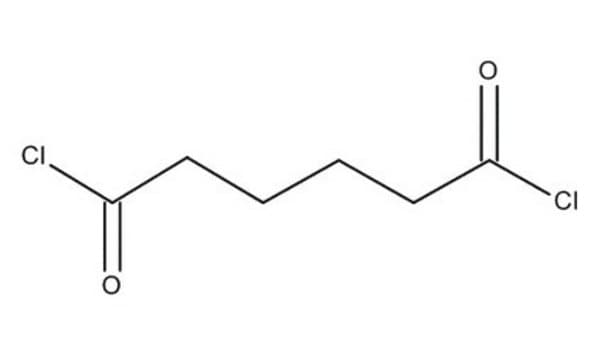165212
Adipoyl chloride
98%
Synonyme(s) :
Adipyl chloride
About This Item
Produits recommandés
Niveau de qualité
Pureté
98%
Forme
liquid
Indice de réfraction
n20/D 1.471 (lit.)
Point d'ébullition
105-107 °C/2 mmHg (lit.)
Densité
1.259 g/mL at 25 °C (lit.)
Chaîne SMILES
ClC(=O)CCCCC(Cl)=O
InChI
1S/C6H8Cl2O2/c7-5(9)3-1-2-4-6(8)10/h1-4H2
Clé InChI
PWAXUOGZOSVGBO-UHFFFAOYSA-N
Vous recherchez des produits similaires ? Visite Guide de comparaison des produits
Catégories apparentées
Description générale
Application
- A coupling agent in the synthesis of PEG-PLA-PEG triblock copolymers, enabling the formation of unique polymer structures with potential applications in drug delivery systems, tissue engineering, and controlled release systems.
- A cross-linking agent in the synthesis of biodegradable aromatic-aliphatic poly(ester-amides) from monolignol-based ester dimers. These polymers possess favorable characteristics like exceptional mechanical strength, biodegradability, and thermal stability, making them suitable for a range of applications including, controlled drug delivery systems, and environmentally-friendly packaging materials.
- Used in the preparation of biphenyl end-capped liquid crystals.
Autres remarques
Mention d'avertissement
Danger
Mentions de danger
Classification des risques
Skin Corr. 1B
Code de la classe de stockage
8A - Combustible corrosive hazardous materials
Classe de danger pour l'eau (WGK)
WGK 3
Point d'éclair (°F)
233.6 °F - closed cup
Point d'éclair (°C)
112 °C - closed cup
Équipement de protection individuelle
Faceshields, Gloves, Goggles, type ABEK (EN14387) respirator filter
Certificats d'analyse (COA)
Recherchez un Certificats d'analyse (COA) en saisissant le numéro de lot du produit. Les numéros de lot figurent sur l'étiquette du produit après les mots "Lot" ou "Batch".
Déjà en possession de ce produit ?
Retrouvez la documentation relative aux produits que vous avez récemment achetés dans la Bibliothèque de documents.
Les clients ont également consulté
Articles
Atomic layer deposition meets various needs including semiconductor device miniaturization and nanoparticle coating.
Notre équipe de scientifiques dispose d'une expérience dans tous les secteurs de la recherche, notamment en sciences de la vie, science des matériaux, synthèse chimique, chromatographie, analyse et dans de nombreux autres domaines..
Contacter notre Service technique







